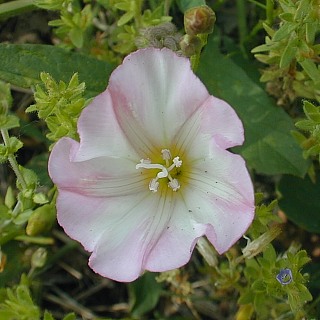Description: This perennial plant is a herbaceous vine that produces stems 2-4' long. The stems are usually glabrous, but are sometimes hairy where new growth occurs. The alternate leaves are 1-2' long and half as much across. They are often sagittate (arrowhead-shaped), but are variable and can assume other forms as well. Their margins are smooth and occasionally slightly ciliate. Long slender petioles connect the leaves with the stems. A slender flowering stalk may develop from the base of a petiole. This stalk occasionally branches and can produce 1-3 flowers. The corolla of a flower is funnelform in shape and up to 1" across; it is usually white, sometimes with light pink patterns. The 5 lobes of the corolla are very shallow and barely perceptible. Toward the throat of the corolla is a patch of yellow and the reproductive parts, consisting of 5 stamens and a pistil with a divided style. These reproductive parts are usually white, although the anthers may be pink or light purple in flowers with pink corollas. At the base of the flower, there are 5 green sepals that are much smaller than the corolla. Up to 1" below the base of a flower, there are a pair of small green bracts on the flowering stalk.

The blooming
period can occur from late spring to early fall, and can span several
months, even though individual flowers persist for only a single day,
usually opening during the morning and closing by late afternoon. A
hairless and well-rounded seed capsule about ¼" long replaces each
flower; each 2-celled capsule contains 4 seeds. These dark seeds are
3-angled and oblong, but tapering somewhat at the ends. Each seed
usually has 2 flat sides and 1 convex side; it is about 1/8" long. The
root system consists of a slender taproot that branches frequently; it
can extend 20' into the ground. Rhizomes are also produced in
abundance, so that this plant often forms vegetative colonies.
Cultivation:
Field Bindweed prefers full sunlight and mesic to dry conditions. It
has considerable drought tolerance, and flourishes in poor soil that
contains sand, gravel, or hardpan clay. It will also grow in moist
fertile soil, but dislikes competition from taller plants. Eradication
of this plant is difficult, as mechanical cultivation often spreads the
rhizomes around, producing new plants. Because of the deep root system,
it has been known to survive bulldozer operations. It can also persist
in lawns, notwithstanding regular lawn-mowing. The application of
broadleaf herbicides can be an effective control measure, if it is
repeated as needed.

Range & Habitat:
Field Bindweed is a common plant that has been reported from most
counties in Illinois (see Distribution
Map); it is native to Eurasia. This plant continues to spread
and probably occurs in every county of the state. Habitats include
lawns, gardens, fields, clay banks, areas along roadsides and railroads
(including ballast), vacant lots, and miscellaneous waste areas. This
plant occurs primarily in disturbed areas.
Faunal Associations:
Mostly long-tongued bees visit the flowers for nectar, including
bumblebees and little carpenter bees (Ceratina spp.). In
addition,
specialist bees that are attracted to funnelform flowers also visit the
flowers for nectar, including Melitoma
taurea (Mallow Bee) and Cemolobus ipomoeae (Morning
Glory Bee). The adults and larvae of several tortoise beetles are known
to feed destructively on the foliage of Field Bindweed, including Charidotella sexpunctata
(Golden Tortoise Beetle), Chelymorpha
cassidea (Argus Tortoise Beetle), Deloyala guttata
(Mottled Tortoise Beetle), and Jonthonota
nigripes (Black-legged Tortoise Beetle). Other beetles
that feed on this plant include Chaetocnema
confinis (Sweet Potato Flea Beetle) and Typophorus nigritus
(Sweet Potato Leaf Beetle); see Clark et al. (2004). The larvae of a
sawfly, Sphacophilus
cellularis, feed on the leaves of bindweeds (Convolvulus spp.),
as do the larvae of several moths, including Bedellia somnulentella
(Morning Glory Leafminer), Spragueia
leo (Common Spragueia), Emmelina monodactyla
(Morning Glory Plume Moth), and Agrius
cingulatus (Pink-spotted Hawk Moth); see Smith (2006),
Cranshaw (2004), Covell (1984/2005), and Wagner (2005). Field Bindweed
is not a preferred food source for mammalian herbivores because the
foliage is mildly toxic. Furthermore, there have been reports of the
rootstocks poisoning swine.
Photographic
Location: Along a railroad in
Urbana, Illinois. This plant is very common in the area.
Comments:
Field Bindweed is an attractive plant while it is in flower, but it can
be very aggressive and persistent. The flowers are smaller in size than
Calystegia sepium (Hedge Bindweed) and Ipomoea
pandurata (Wild Sweet Potato). Its leaves are sagittate,
while the leaves of Ipomoea pandurata (Wild Sweet
Potato) and Ipomoea
lacunosa (Small White Morning Glory) are cordate.